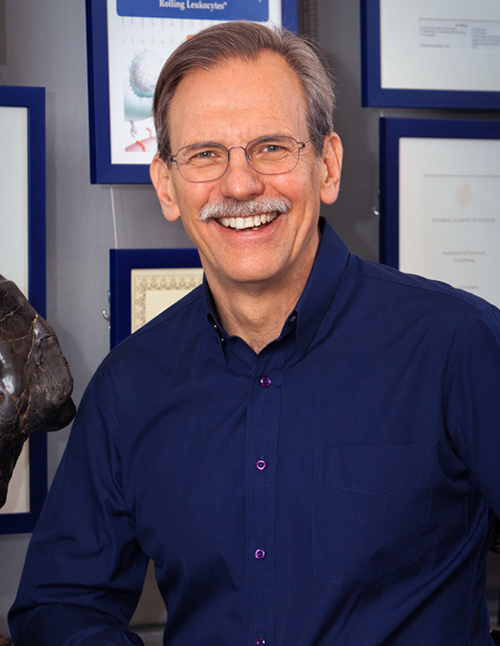
The 2022 Albert Lasker Basic Medical Research Award has been presented to Richard O. Hynes, Ph.D.; Erkki Ruoslahti, M.D., Ph.D.; and Timothy A. Springer, Ph.D., for discoveries concerning the integrins—key mediators of cell-matrix and cell-cell adhesion in physiology and disease.
Timothy Springer is a long-time user of the U.S. Department of Energy’s (DOE’s) Advanced Photon Source (APS), a DOE Office of Science user facility at Argonne National Laboratory. He has to date published 40 papers based on research at the APS, 22 of which are related to the study of integrins. These studies by Springer and his colleagues were carried out at the National Institute of General Medical Sciences and National Cancer Institute (GM/CA-XSD) structural biology facility at APS Sector 23, the Northeastern Collaborative Access Team (NE-CAT) center for advanced macromolecular crystallography at APS Sector 24, and the Structural Biology Center (SBC-XSD) national user facility at APS Sector 19.
The Lasker Awards program was created in 1945 by Albert and Mary Lasker to shine a spotlight on fundamental biological discoveries and clinical advances that improve human health, and to draw attention to the importance of public support of science. The Albert Lasker Basic Medical Research Award is “For a fundamental discovery that opens up a new area of biomedical science.”
In announcing the award, the Lasker Foundation noted that “Independently, Hynes, (Massachusetts Institute of Technology), and Ruoslahti, (Sanford Burnham Prebys, La Jolla) identified a cell-surface-associated protein that helps affix cells to the surrounding material, the extracellular matrix (ECM). Then the researchers captured a receptor to which this protein binds. In seemingly unrelated studies, Timothy A. Springer (Boston Children’s Hospital/Harvard Medical School) discovered transmembrane proteins that underlie the ability of immune cells to interact with their targets. These initially disparate lines of inquiry would converge and mushroom after the investigators realized that the proteins—now called integrins—belong to the same molecular family. Its members play central roles in an astounding array of processes in embryonic and fully formed organisms, and they offer intervention points for treating myriad diseases.
More information on the award, including a “2022 Basic Award video” can be found on the Lasker Foundation web site.
GM/CA-XSD is funded by the National Cancer Institute (ACB-12002) and the National Institute of General Medical Sciences (AGM-12006, P30GM138396). NE-CAT beamlines are funded by the National Institute of General Medical Sciences from the National Institutes of Health (P30 GM124165). SBC-XSD is funded by the U.S. Department of Energy, Office of Biological and Environmental Research and operated for the U.S. Department of Energy Office of Science under Contract No. DE-AC02-06CH11357. The Advanced Photon Source is a U.S. Department of Energy Office of Science User Facility operated for the U.S. Department of Energy Office of Science by Argonne National Laboratory under Contract No. DE-AC02-06CH11357
____________________________________________
The U.S. Department of Energy's APS at Argonne National Laboratory is one of the world’s most productive x-ray light source facilities. Each year, the APS provides high-brightness x-ray beams to a diverse community of more than 5,000 researchers in materials science, chemistry, condensed matter physics, the life and environmental sciences, and applied research. Researchers using the APS produce over 2,000 publications each year detailing impactful discoveries, and solve more vital biological protein structures than users of any other x-ray light source research facility. APS x-rays are ideally suited for explorations of materials and biological structures; elemental distribution; chemical, magnetic, electronic states; and a wide range of technologically important engineering systems from batteries to fuel injector sprays, all of which are the foundations of our nation’s economic, technological, and physical well-being.
Argonne National Laboratory seeks solutions to pressing national problems in science and technology. The nation's first national laboratory, Argonne conducts leading-edge basic and applied scientific research in virtually every scientific discipline. Argonne researchers work closely with researchers from hundreds of companies, universities, and federal, state and municipal agencies to help them solve their specific problems, advance America's scientific leadership and prepare the nation for a better future. With employees from more than 60 nations, Argonne is managed by UChicago Argonne, LLC, for the U.S. DOE Office of Science.
The U.S. Department of Energy's Office of Science is the single largest supporter of basic research in the physical sciences in the United States and is working to address some of the most pressing challenges of our time. For more information, visit the Office of Science website.
